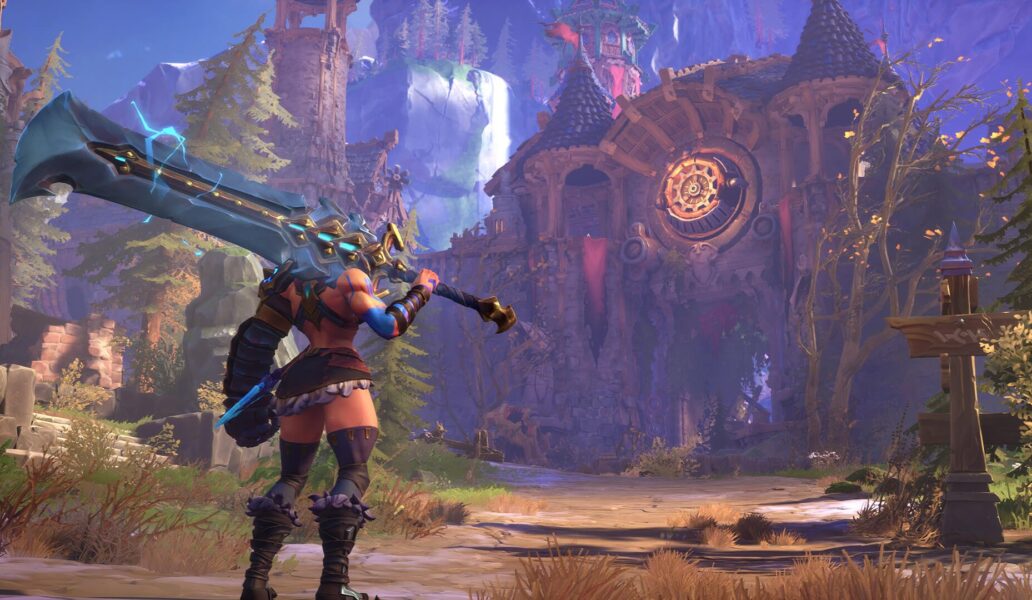
Wayfinder – Airship Syndicate
Wayfinder is a co-op arpg featuring randomized dungeons, massive open-world zones, hundreds of unique creatures to fight, and much more by Airship Syndicate
Role: Game Designer
Team Size: ~70 employees
Duration: March 2022 – October 2024
Engine: Unreal 4
Release:
- Initial MMO EA release August 17th, 2023 on Steam, Playstation 4 and 5.
- Co-op ARPG EA release was June 11, 2024 on Steam
- v1.0 release was Oct. 21, 2024 on Steam
Quick Highlights
-
25+ Events Designed | 30+ Managed | Tools Adopted Cross-Discipline
-
Spline Navigation, Puzzle Systems, Dynamic Combat Encounters
-
Focused on Replayability, Player Choice, and World Reactivity
-
Full Event Lifecycle: Pitch → Prototype → Documentation → Ship → Iterate
Project Overview
Wayfinder is a co-op action RPG featuring procedurally generated dungeons (“Lost Zones”), massive open-world biomes, challenging instanced boss fights (“Hunts”), and player-driven world mutation mechanics (“Imbuements”).
As a Game Designer, I led the creation, implementation, and iteration of more than 25 unique Events, while managing over 30 others. My work focused on encounter design, systemic gameplay, dynamic world systems, and collaborative content pipelines in Unreal 4.
Key Responsibilities
Event Design & Systems Ownership
-
Designed 25+ unique Events and Hunts from concept to shipping, varied mechanics, progression gating, and layered combat.
- Multiplayer Systems: Replication, networked logic, synchronized systems
-
Established foundational pillars and systems that define how procedural Events and Lost Zones function and replay.
-
Integrated Imbuements into Events to enable player-driven gameplay changes, rewarding experimentation and replayability.
-
Created hybrid Events combining combat, puzzle-solving, player choice, and narrative hooks.
- Implemented gameplay systems using Blueprints, including clear documentation and modular organization to support future iteration and cross-team usability.
Procedural Generation & Encounter Logic
-
Managed and expanded the procedural event generation system:
-
Introduced event weighting, prioritization, and cost-budget tuning to balance randomization with quest relevance.
-
Refactored event tiers and budget logic for more deterministic level planning.
-
-
Oversaw level tile availability and configuration, ensuring required tiles spawned for static and random Events.
Technical Implementation
-
Scripted core gameplay logic and content in Unreal Blueprints
-
Developed blueprint-powered tools used by narrative and quest teams to guide player navigation dynamically across varying terrain.
-
Supported mission-critical features including dynamic creature spawns, randomized puzzles, and responsive player feedback mechanics.
Cross-Team Collaboration
-
Partnered with combat, environment, audio, and narrative teams to bring Events to life through environmental storytelling, custom encounters, and cinematic integration.
-
Worked closely with world builders to craft non-combat exploratory puzzles for environmental storytelling.
-
Coordinated with artists and engineers to ensure all events fit thematically and visually into the game’s world.
- Tool Design: Custom Blueprint tools and reusable content systems for narrative, quest, and world teams
Design in Action: Select Event Case Studies
Below are six featured events that showcase my design philosophy, Blueprint scripting, and player-centric iteration process. Each includes a Blueprint example (Screen shot and link to blueprintue.com) used in the shipped game.
Highlighted Event Examples
NOTE: In the below event descriptions are blueprint examples that lead to https://blueprintue.com which showcase in greater detail the UE Blueprints I created for these events. The website only allows the raw .xml data from the blueprint and does not allow any further edits. The screens shots are examples of how my Blueprints typically appear and are organized.
Hunting Party (Spline-based Tracking Event)
-
Designed a track-and-hunt encounter using dynamically generated spline paths for VFX-guided navigation.
-
Built a terrain-aware spline generator using line traces to ensure visual clarity across varied topology.
-
This spline system was later used by the narrative and quest team for broader use across tracking-based quests.
Feedback and Changes
- Initial feedback detailed difficulty in following the desired path over varying terrain topology. After a comment about similar tracking methods in ‘Red Dead Redemption’, I designed and developed the terrain-aware spline generation for the VFX to follow across the random paths players must follow.
- Other feedback indicated minor frustration over having to run the full path everytime to find the end encounter. The event was then updated to have a single destination that, after activating the event, players could go straight to the end if they were familiar with the event.
View Blueprint – Hunting Party
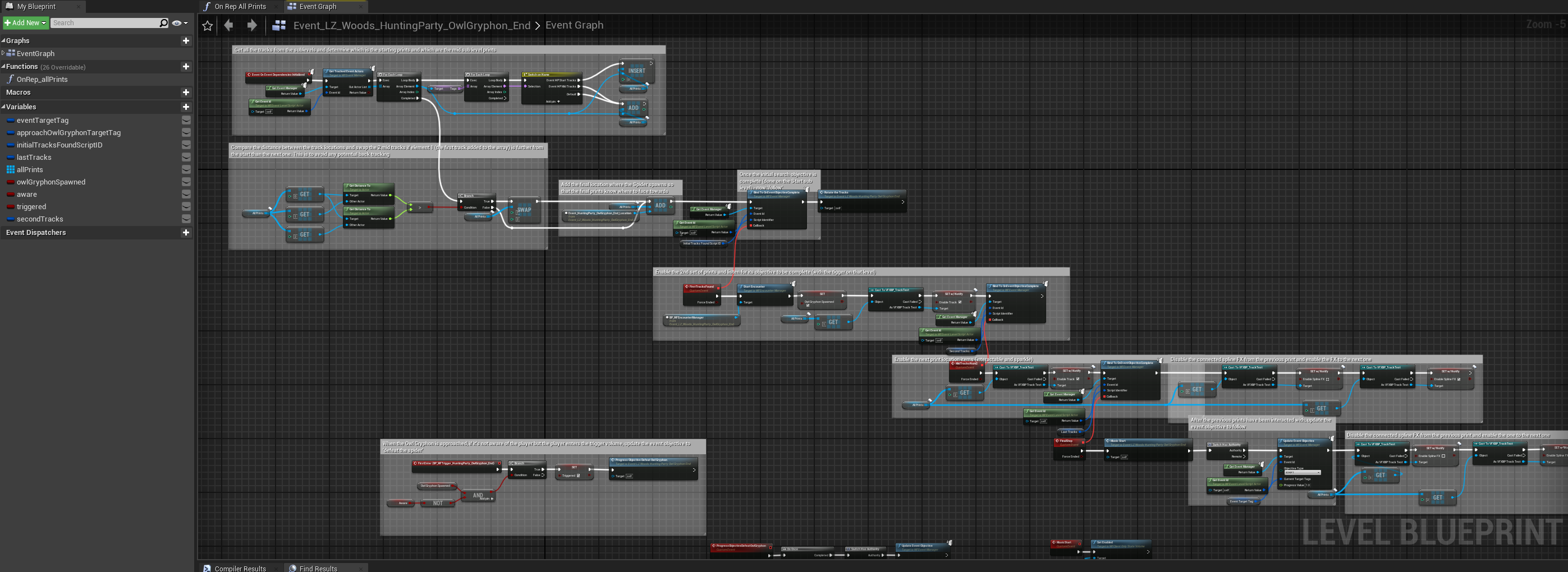
Secret Chamber (Environment Puzzle + Combat)
-
A hidden, non-signposted Event that encourages environmental observation and exploration.
-
Combined randomized console interactions, a miniboss fight, and a rotating ring puzzle with obscured solutions.
-
Used subtle visual markers and gating mechanics to reward player curiosity and reinforce systemic learning.
Feedback and Changes
- The ring puzzle required exact timing to stop the rings in the correct location. Incorporated a larger buffer for players that, once the rings stopped, would automatically align to the exact location.
- Players were initially having difficulty finding the ‘key’ needed to unlock the ring puzzle and not understanding what the key was for. Worked with the art and environment teams to reshape the environment to make it easier to spot the required ‘key’ and ‘lock’. Worked with SFX to ensure a sound cue indicated that the puzzle was unlocked
View Blueprint – Secret Chamber
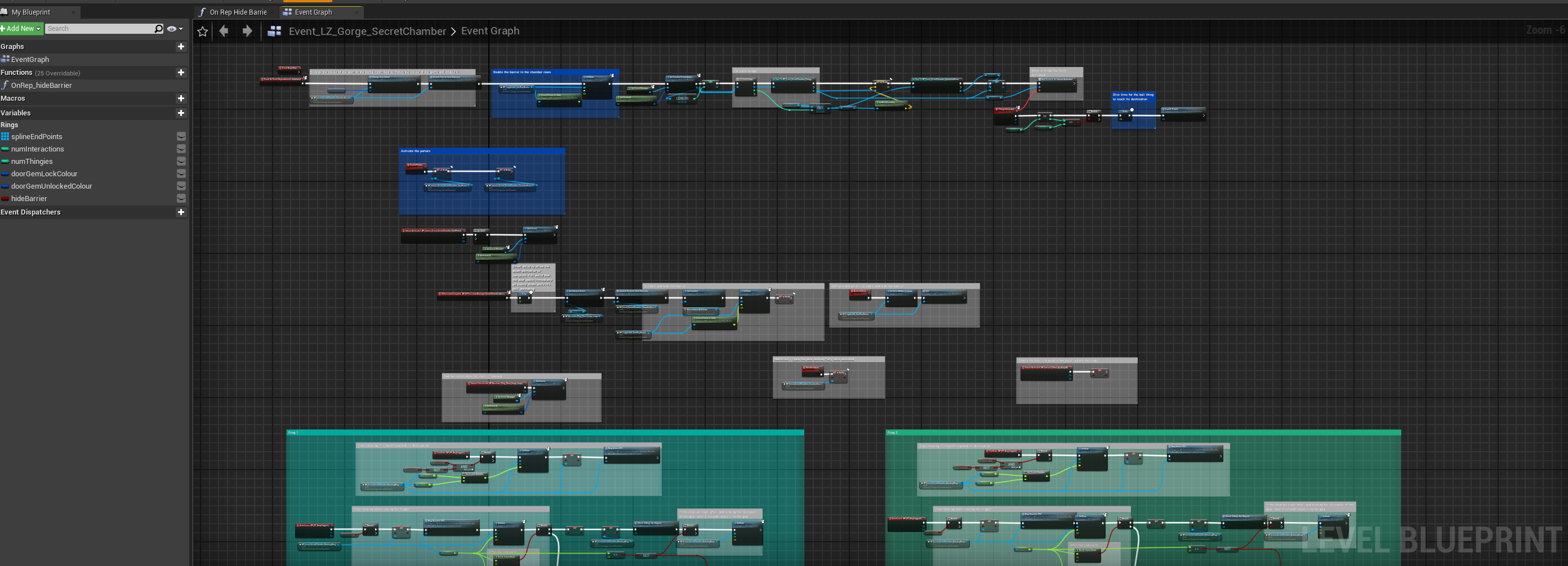
Elemental Overload & Sentinel Charge (Player-Driven Combat Mutation)
-
Allowed players to modify boss mechanics by inserting up to 3 Imbuements, each altering the Sentinel’s abilities and visuals mid-fight.
-
Designed branching reward logic and combat wave variants based on player input.
-
Created glyph puzzle side activity with optional challenge/reward loop and consequences for brute-forcing, ensuring those with the 3 common colour blindness, were still able to differentiate the colours used in the puzzle.
Feedback and Changes
- The initial encounter, before activating the Sentinel Charge, was found to be unusually difficult and wave intensive. Changed the encounter makeup and size to reduce combat pressure in the smaller combat space.
- The colours used in the puzzle were found to be too large and bright. After working with artists, reduced the size of the glyphs, emissives and colours to better represent the major threat of the area
Elemental Overload
View Blueprint – Elemental Overload
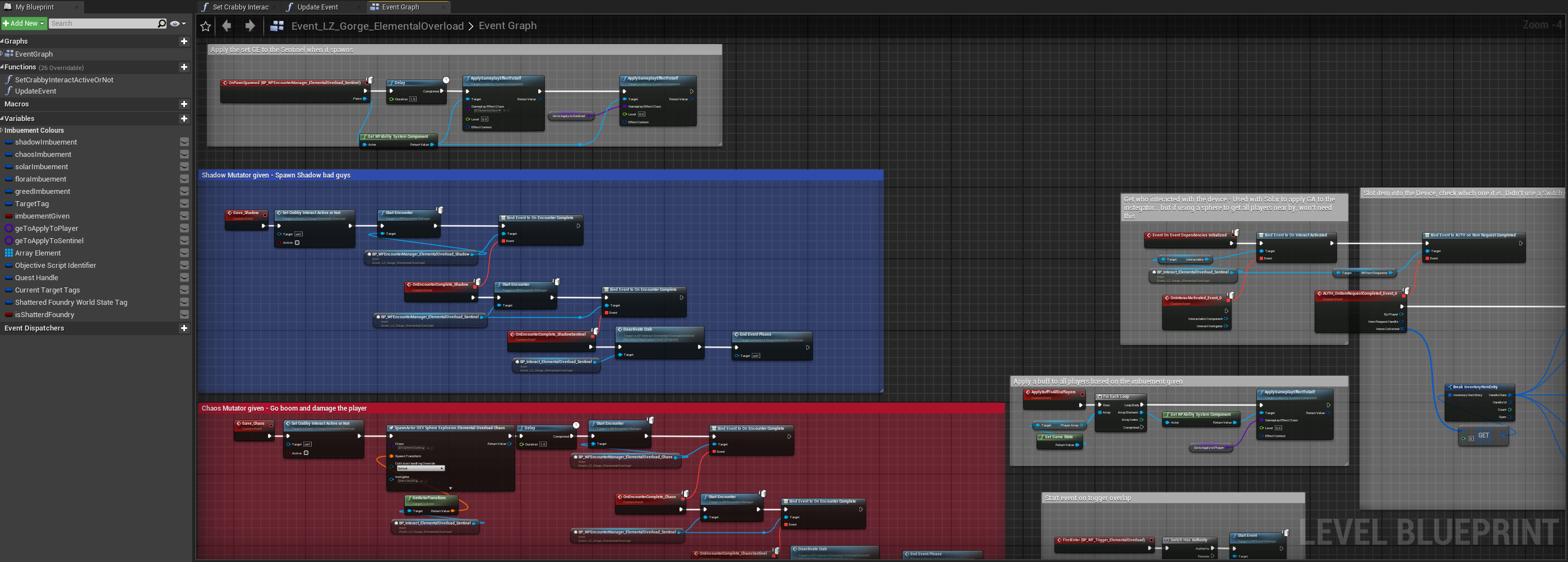
Sentinel Charge
View Blueprint – Sentinel Charge
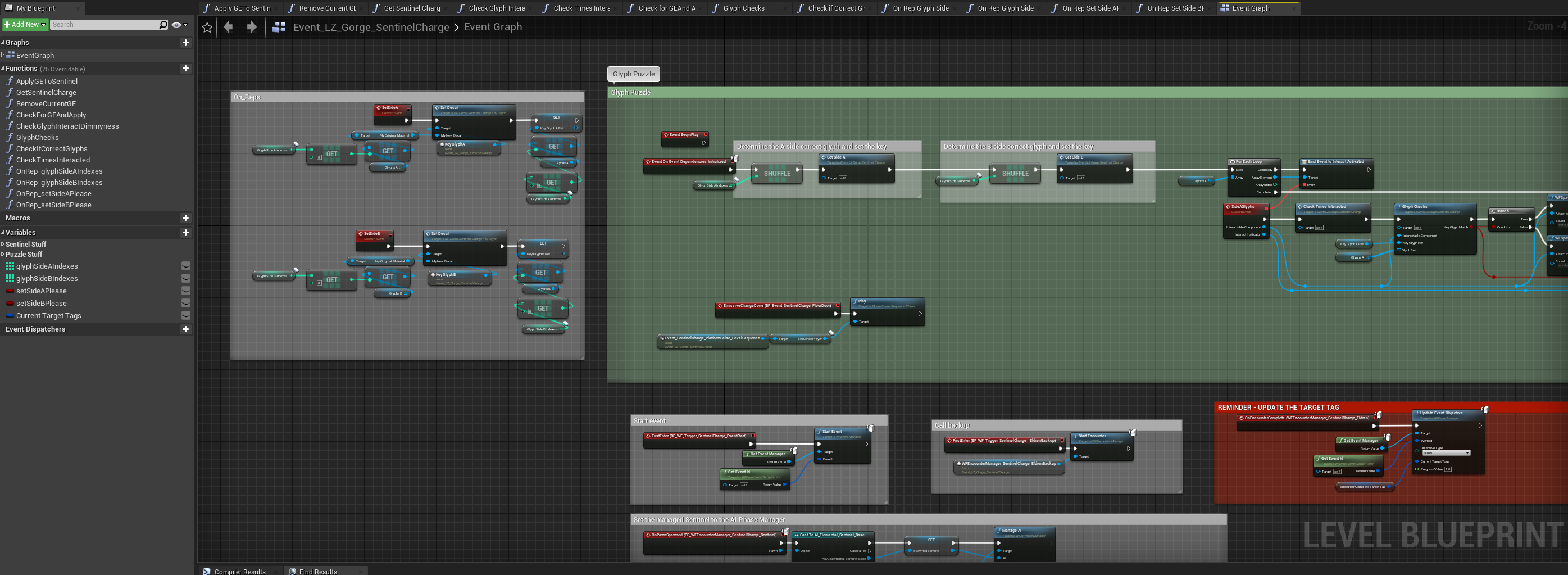
Enlightening Treasure (Logic Puzzle)
-
A non-combat, repeatable event focused on glyph-matching and environmental feedback.
-
Designed to break combat monotony and reinforce factional storytelling through visual puzzles.
-
Featured randomization layers for repeatability and subtle punishment/reward conditions for incorrect logic.
Feedback and Changes
- Feedback included frustration in learning the event due to the limited number of incorrect guesses they could input before being locked out from the reward in the chest. This was removed and allowed players more freedom to learn the event without fear of losing out on the reward
- Players were also having difficulty understanding and matching the runes on the centre rock and the ones on each torch were linked. Updated the glyphs on the stone to change colour (including the initial design of chains being removed from the chest with the event reward for each correct lit torch) with each matching correct lit torch
View Blueprint – Enlightening Treasure

Torches Puzzle (Environmental Interaction & Memory Challenge)
-
A simplified logic puzzle event that used lit totems and scattered resources to create a pattern-recognition challenge.
-
Applied feedback from previous puzzles to improve clarity, pacing, and accessibility.
-
Collaborated with environment and world-building teams to improve visual readability and accessibility (including color-blind support).
Feedback and Changes
- Players were unable to find the required stacks for wood due to them being spread around a large area and too far apart. Reduced the distance for all the wood to be much closer to the event and added a sparkle effect to them to make it more obvious. A stack of wood was visible near the event to indicate to players what to look for
View Blueprint – Torches Puzzle
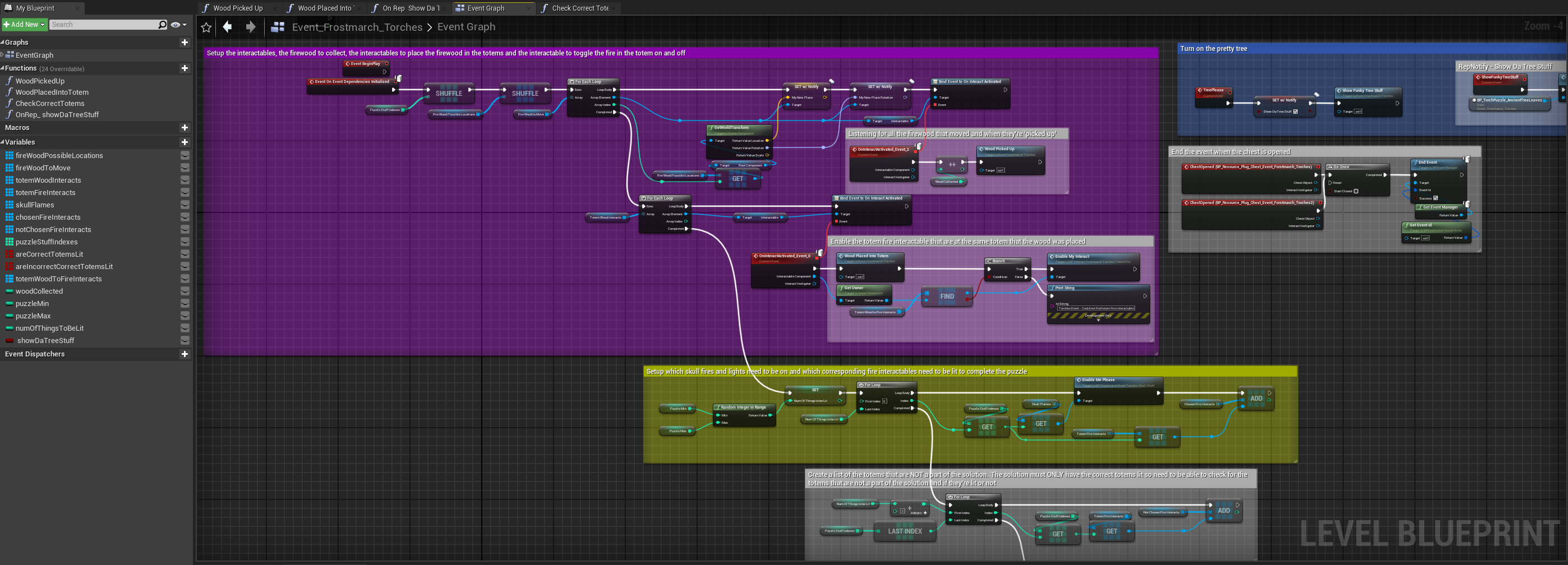
Skills & Tools Demonstrated
-
Game Systems Design: Procedural logic, balance frameworks, combat modifiers, encounter scripting.
-
Visual Scripting (Unreal Blueprints): Tools, VFX routing, event sequences, puzzle logic.
-
Collaboration: Combat designers, engineers, world artists, narrative teams.
-
Procedural & Modular Content: Tiered generation, event weighting, systemic variation.
-
Event Scripting: Trigger logic, player interaction, progression gating, failure states.
-
Player Experience Tuning: Feedback iteration from playtests, accessibility improvements.
